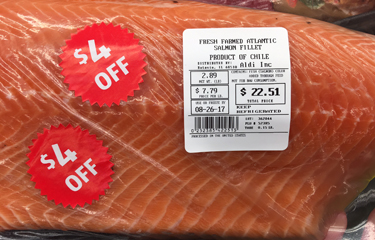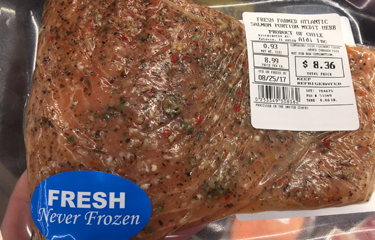ALDI’s continued aggressive push to sell more seafood in the United States – highlighted this summer with its foray into packaged fresh seafood – should have its grocery and fish market competitors concerned.
ALDI’s ability to buy in bulk – along with offering high quality, Best Aquaculture Practices-certified tilapia and salmon – allows the chain of nearly 2,000 stores to offer a competitively priced product that is fresh and tastes good.
In mid-August, ALDI devoted the back page of its weekly circular to tell shoppers about its “certified fresh, never frozen” seafood offerings, which include Atlantic salmon fillets for USD 7.99 (EUR 6.71) a pound, and USD 8.99 (EUR 7.54) per pound for the salmon fillets seasoned with Mediterranean herbs. Fresh tilapia fillets were going for USD 5.49 (EUR 4.61) per pound and the store was selling its “Garlic Herb Tilapia Fillets” for USD 6.49 (EUR 5.45) a pound.

Steven Johnson, a consultant on the grocery industry at Foodservice Solutions, said seafood represents akey piece of ALDI’s expansion strategy in the U.S.
“ALDI is currently remodeling most of its U.S. stores with a clean, brighter, fresher look. The new image will be edified with the addition of fresh seafood,” Johnson said. “Simultaneously, [offering] fresh seafood for less than most legacy grocery retailers…will drive differentiation and incremental customer migration.”
ALDI is able to offer lower prices than many grocery competitors by buying in bulk and by limiting their offerings to just a small number of highly popular products, or stock-keeping units (SKUs), according to Bill Bishop, co-founder of Brick Meets Click, a retail advisory and consulting firm.
“Species are limited to just two favorites – salmon and tilapia – and only five SKUs, so shrink is limited,” Bishop told SeafoodSource.
Bishop said customers also must like the fact that the quality of ALDI’s fresh seafood quality is high.
“We tried the farm-raised salmon recently, and it was a great eating experience. It was far superior to the farmed salmon sold frozen at Costco,” Bishop said.
And, for ALDI customers who don’t have experience preparing seafood, the company now offers 60 main dish seafood recipes, including ingredients, directions, and cook time on its website, Bishop wrote in a recent blog post.
Seafood suppliers will also benefit from ALDI’s bulk-buying policy as well as their streamlined buying process, according to Bishop.
“Suppliers find them both fair and easy to deal with. In the produce business, people love doing business with them,” he said.

Seafood retailers – especially those who are only marginally committed to the fresh seafood department – should be concerned about ALDI’s offerings and how they may change the perception of self-serve seafood in the U.S., Bishop said.
“It will be felt by some of the retailers who are half-in, half-out on seafood,” Bishop said. “Perhaps they have a 12-foot section, with service some of the time and a disproportionate amount of seafood there.”
Johnson agreed, putting middle-market grocery retailers on the East Coast of the U.S. on notice. He cited Albertsons, Kroger, and Publix Super Markets as the chains most likely to lose market share to ALDI.
ALDI’s efforts are likely to have an even larger ripple effect on U.S. supermarkets, according to Bishop.
“ALDI’s philosophy is, ‘We have some really good product that is fresh, perishable, and available while supplies last. We will let the case sell down.’ That is [the] opposite of [current[ retail philosophy in the U.S.,” he said. “People are going to take a leaf out of the ALDI book and probably significantly contract what their self-service offer is and concentrate on the items that really move.”
Bishop said retailers will likely buy and display seafood differently in the future, thanks to ALDI’s European style of producing and packaging fresh seafood. Expect to see smaller, more focused, more tightly-managed self-service cases, he said.
“Suppliers should take some responsibility for controlling the flow of inventory into [their seafood] departments and, as a consequence, the shrink,” Bishop said. “The consumer would have access to a better product.”






